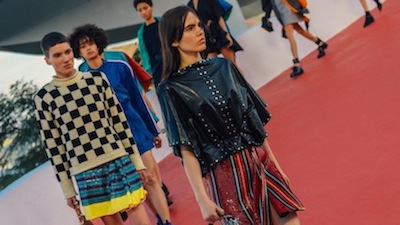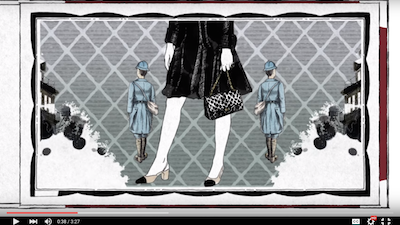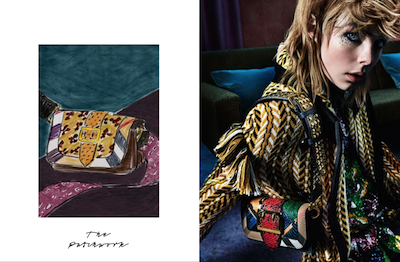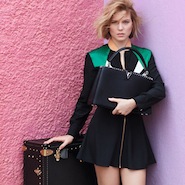France’s Louis Vuitton is ranked as the world’s most valuable luxury brand for the eleventh year running, according to the 2016 “BrandZ Top 10 Luxury Brands” report.
While there is strong appreciation for luxury brands, slowing economic growth has put constraints on consumer spending, but the comforts of displaying one’s affluence have returned since the global financial crisis of 2008. As a whole, the luxury category’s value declined by 5 percent from the year-ago period, resulting in a top 10 brand value of $99.7 billion.
"It has been interesting to watch the impact of a changing global consumer as Chinese consumers become more sophisticated," said Susan Hickey, senior vice president of marketing at Millward Brown. "So while previously, Chinese consumers were more about displaying luxury brands and logos for effect, it has become more about the meaning and stories behind the brand, and less about the bling effect.
"For example, Christian Dior, new to the luxury category ranking this year, invested in marketing its perfumes in China – perfume being a more personal, less visible item," she said. "It has also been interesting to see partnerships and sponsorships emerge and expand.
"Hermès, the number two luxury brand, partnering with Apple, the number two brand in the world, to market a watch band (see story). Rolex, the number five luxury brand, continued its sponsorship of the Rolex 24 at Daytona, emphasizing performance and achievement. These partnerships and sponsorships are more often seen with mass market brands, so we’ll be keeping an eye on how these partnerships create value for luxury brands and customers."
Millward Brown’s BrandZ report ranks among the top 100 most valuable global brands across categories. The study measures brand equity based on interviews with more than 3 million global consumers regarding consumer-facing and business-to-business brands.
The BrandZ Top 10 Luxury Brands is an excerpt from the “Top 100 Most Valuable Global Brands” ranking that examines only labels in the luxury industry. For the purpose of these rankings, luxury was defined as high-end clothing, leather goods, fragrances, accessories and watches.
Luxury at its finest
When combined, the most valuable global brands of 2016 have a brand value of $3.4 trillion. Over the past 11 years, since the ranking was established in 2005, brand value has risen steadily by 133 percent.
Ranking one through five of the BrandZ Top 100 Most Valuable Global Brands 2016 are Google, Apple, Microsoft, AT&T and Facebook. The only luxury apparel brands to rank within the 100 are Louis Vuitton at 30, up from last year's spot at 34, Hermès at 44 and Gucci at 80.
When examining just the Top 10 Luxury Brands, three brands in the category were the only to show growth: Louis Vuitton, Hermès and Chanel.
"Even in a category like luxury, often viewed as more traditional, technology is driving change among consumers," Ms. Hickey said. "This creates a particular challenge for luxury marketers as they balance exclusivity with current clients, with accessibility to new customers as they grow in affluence and style.
"The key is to remain true to the brand while using communications channels that serve the brand," she said.
Ranking number one out of the Top 10 Luxury brands, Louis Vuitton has a brand value of $28.5 million, a 4 percent increase from the year-ago. In 2015, Louis Vuitton saw a brand value of more than $27.4 billion.

Louis Vuitton cruise 2017 collection
Comparing the brand’s value further, in 2014, Louis Vuitton was valued at $25.873 billion, a 14 percent growth from 2013. Year-over-year, Louis Vuitton has shown innovations that fueled consumer interest but maintained the allure and exclusive narrative of the French house (see story).
France’s Hermès, ranking number two, also recorded growth of 5 percent. The leather goods brand is valued at $19.8 million for 2016, up from $18.9 million in 2015.
Seeing the most brand growth was Chanel at 15 percent. The Parisian atelier ranks fourth on the list with a brand value of $10.3 million for 2016, up $1.3 million from the year-ago.
The list of luxury brands is rounded out by Gucci at number three with a value of $12.5 million, but a brand value change of -9 percent from 2015 despite rejuvenated interest in the house since the appointment of Alessandro Michele as creative director.

Gucci pre-fall 2016
Also seen within the top 10 were Rolex, Cartier, Burberry, Prada and Tiffany & Co. A newcomer for this year’s BrandZ ranking is French fashion house Christian Dior, which ranked tenth.
For the aforementioned luxury houses, communicating brand story is an intrinsic value strategy used to cultivate brand experience and generate consumer-brand love.
Chanel, for example, schooled consumers on its design lexicon in an edition of its Inside Chanel series.
“The Vocabulary of Fashion” flips through an imagined dictionary of Chanel terminology, which includes notable codes such as pearls, the camellia and tweed. Throughout this video, the brand documents the details that both house founder Gabrielle “Coco” Chanel and present creative director Karl Lagerfeld incorporate in their garments and accessories, providing proof of Chanel’s enduring, timeless aesthetic (see story).

Inside Chanel video still
Likewise, Louis Vuitton quite literally packed its bags to take its most recent retrospective to Tokyo.
In its original form, the “Volez, Voguez, Voyagez” exhibit was staged in Paris’ Grand Palais, tracing Louis Vuitton’s steps as a trunk maker. The site of the exhibit itself held a special place in Louis Vuitton’s history, as the brand’s luggage and bags were showcased there during the Universal Exhibitions in 1900 (see story).
"Louis Vuitton has been the top luxury brand for a number of years - it is a brand that continuously remains true to its heritage and brand, while also looking to the future," Ms. Hickey said. "This year, for example, it evoked its brand heritage as a maker of trunks and other travel goods by creating an exhibition of trunks, tools of the craft, and other travel articles from its collection for the Grand Palais in Paris.
"The brand originally displayed its wares at this grand venue during the 1900 Universal Exhibition (World’s Fair)," she said. "Louis Vuitton absolutely knows it customer, tightly manages sales channels, and have, over the year, curated, rather than simply sponsored, unique Louis Vuitton campaigns and brand experiences."
Trouble at the top
While Burberry, Prada and Tiffany & Co. are listed among the category’s top 10 brands, all three are in the midst of financial struggles.
Ranked seventh, Burberry has a brand value for 2016 of $4.5 million, a decrease of 20 percent from 2015. Prada, ranked eighth, is valued at slightly less at $4.4 million, a steep decrease of 33 percent from the year-ago while number nine, Tiffany, is valued at $2.4 million, down 24 percent from 2015.

Burberry 2016 campaign with Edie Campbell
To account for financial strains, brands such as Burberry have unveiled plans to improve profitability. The label has established a three-year strategy that will cut costs by 100 million pounds, or about $146 million per year by 2019, enhance productivity and spur revenue growth.
Throughout the 2016 fiscal year, the brand already saved approximately 25 million pounds, or $36.5 million, compared to its planned expenditures by closely managing funds (see story).
After the plan was announced in mid-May, Burberry told shareholders that its CEO/creative director Christopher Bailey’s salary would be cut by 75 percent due to the British fashion label’s financial woes.
"Corporate earnings are a part of the BrandZ valuation methodology, so company’s financial performance will impact rankings," Ms. Hickey said. "These brands, along with the overall category, were also affected by slower growth in China, Brazil and Russia."
{"ct":"mwsFp96qIz4vwWp8734\/KcJc3qiDYt4T2mrCmaww2y5yGR3HjXF7A4E5b9xUr3B8OlzW9PxnCoFan4MZWeMHDrA2tTWcfj+JlIFakLbx5Wcum2GiUZSq5mXZiLmaxxwnulq+E0gmZeLF8bOPXNi0omeVGqz56EVJnypEEU58pHXKQaZGrzyaKcXnDhnPWu0NbgECxbjJTlRSDEDBQvdndXb0Rj0TzwMZNmJblcXIAOv3GYN2gHA314sPN22nDCVPLvp29f05WqFx8Z6mHvuh9xdEyFGjEZ\/cP7IGP3GSOFXCDLGjykoxohxD9RjaRlBD6PPgci2A1vMtbRyJnIqiEpLt\/QbpN+Zq42Q4x\/+nKm2aTaMdlB4yubDHSJmuPgyVcTM16TYiuP8yPTDp79BUGMMu+QXfjWBFiy96QXW+WD027rogjBR0wxs691K4pqbVgwjZKlY4RY5tC8cY31jfQuEGSf+z8hnMaynQumvbjr+d5MTJrRTRhcRnYuqnKLR4KZwFugz2R6HC2xjs119j9pKogzCffH3Vns22C8LCiL2HOXamm6VkWsyX8klGuMDeywlwJ5+iuWmuZDIOG4N3S1kmpf7O\/1JjeeLTJNAApNkoDH9Ai+BROqMn3jy1zGl3BJQKmV6xVEZ6CsJh3wXhWrY\/ENXZZxge1dj1L12KOyYwQ5ndW9\/BqKUoiLaKsr2IIwAw22APsvCCtRfFPt7sw8NiddqJMLu6Ws+hSiFDiLYOej05hOPhwUGvqfmtt3n9qaJzLVeR7\/Km8OZccuUBrUBYFi1mIu3jD9MHLPlfoIo70VVUwlwH2Xil9DqJ5QHmeO\/fYvKYPt1dtiyrz6cNOExV\/sWDNZ0XUcPL03cOAJzJeaoFlS0tcLjFSCzAhZ4ncuAdvs4WaCkD5mLzWfPZXLykavK1JB3eJb9kLn1ZgVLjehJVEL9Vkt9fTguR8UYD8omcuro9aohQQiJ9O3VJHv007xppBx0HnzFTeXCj0fgX15dU9rxD\/2cvX7hMnv0L5bnjXM8qnoelGCrxixaQiQ6kP26t1PdkhBnwvMChb4qGPBj8TZAs8XA+o0CNjiIVRwrqSsyaXlYNJ4jwuIf3\/XxZsVuiuCkGPENJp\/aX2mlRnEHlveFSBhMAT0fSPaBWmH7KnctOTSWXb62DrZSm5AvjM+VoHpRUHlkZ3PItyTgb\/wkFxgfdZlTo1QENLV0NaqupGMMjN23\/7E8U38nxML080v0Q7\/xBACARE5Z2DLLumaMgBmWJ+lCjZWfaubNk7cOQb4sPUanWDnzk9uDvZ\/VVV00CQWQzN\/KZIt9AkKRpSi0lGo4bXQX5vz01Gpl5rQfWQCwLjPP\/Kfw3EZTxlnD\/3eqBXejPDJI3l9L5edBhpgol6wbXsRSRVhgp0+qiRe2AVbW7uqzsHtf\/70lExzQF99h0xWB9acg2Ytl8\/Tw98FJUxnvZGIyauPsFpgpcxJdnXJqypVIgTtYgbPVr0Y3KPMY\/STMyFZxhsg5\/zkG5BzOPxq\/iIME8kwZS9vRB79GatkqUrMgDUogZHQKjcyph65KYgsfNSZWXN+K2WTtsknAxcVtXLa32572yUANf1ltIz7quJ9vkDVJi428y\/UCf3jo+JbCP8yYqoxn0PgaeeME3CYS2KL162YzeSARRcEjD1\/uyPqxZdxW87Hr20G1IOuRDaGfhygiQNXAlLW5VKOKADcMzg4gUCWXMd7uCaVPNHhqfIJMdszNzyB8b7dSmCratur\/YIZg7SyHxW0zgnvMYruBRllNxrD+Qbbbfebo9kEyrQKeHwFmcoyxjWaa+ppHiDBgYw1Rdha\/Cw+P4cFXJ\/dXFLOwgxcoWEVvgFWCzIlTVdVfmn+HeSI9maaxQpgJvsxdxKAc2V9ddIHcrIwKWrnpEXac4CvMdV\/E16ZG118DCJqHdne0NACv+yeAPDNtJc0dPVWTyy7QC\/iz6eKYTh8aWx\/RChiuk7Rp44Qu0a9mpKG1MHMgoIxnHtEKJu1ahDqSeErwP47B+EsujaLGz\/PIA8xsRSr353Vc135Ljuj1rXZdu1bQemg+bphjmRw\/KZ9lElZELVA688kYRT6oVBrjIiBFF7MSUBhZeAht7+bf3CWlD51AC507FgMV6rIUHYmOOal7CVG8H7KFAjDG6F+59KwUIqcrgVs\/HCWXvTu5oJoddzCfLfb70BEuYwAL1yAFJSzambGrD+4Pjeg\/qckQ4n8CAPdGEp6LyrP0ulid3RyHdJmguEmU0HLBaZLi4a3Uoh9wKYzRjdSvs5Fmzx4riBX\/99ypFlMTGdoITQU\/\/iqUDxoru1yDObZJQBM2KOQQsonoyI1mTI3HZ9O1YcIbsf+3jH8rlwlCSPpztJ\/u1ZkyK1Uear2B5w97byexrR82GnzHmZmzRAWES6xlWTiHCebLAo2jBQwd8GYjAlLleApm4hxskTrvt4p1MefcR2i9zJu2MEiVagfE1xQFRAttD+cN8xsVwpNNDP2PjtHvlGC0G4RisJ+5pT4mfBMBMzPbeX5o8t6kuZDSVRpcvGqOCESDI3L\/\/SMVBW1E4nq3\/xeCuqz7zu1iXYwSa7aams6EugfqFGe+qaT5+ofYseRMzGxRfdZT5nufpMa0U6ibVI7bVRUF4Wy\/YGSAeJkCUYRScfOFVrFtPy\/0mnNVtaHn5KnXUFK\/y+nbNxJMVEdUIXUMGa0\/uf+YxJs1mSk5PY3zF1nK9Ip6Jk1nnkVNeNcN2+w9E3Yjpq5HN2y5ap5vAF4Y2AJdbw\/vUhqwglYdgJxHVhijFg3RLkaySQvXeYaEnIZ4naEtQXVUIvObNm34qKAD8H9hv3JcZpgK6NtZterEKJOVXe7\/qMBc35yYxMI6UpZZ1zU2FicdxAcUc0ABbpt2CJlnpBB6Z34UC67soCR5xTpUL8ERtje9mmJVQqGmbjaEkfMOZBVWhqgCbIjpHhPlviVt8f\/g1TccQ\/uL0T3ml8+RZ1xWzksONZFXTXEetOmMcKvCUnhoyxQExBI27KaEGrqQZ8ZEBt4FxL+oamUtOAXbj\/WWEjbj1xR3yqvI8rMnpLGSwBAVyuOy7N7YbuwZHhaG7juBliGrjYG6Woewp5u2FsqwouTzGznKJrfgQalLb8LzWPDtLD1IrqBc+N3BflHPDjz1Nov8v4c+c6XTSm1Xcv0toryKQ6TMjce9RQtA7mszpp\/ghsKuwcDWToEWvTot84Tmk8CfRmmxEc6h7yjxl9IijbczMpkW+mIrgGIPhPJSqMRFQ3VHFs8V7elxuHOpYmGd8M+34u6Q72CmIfbuXE\/SYPp3Ejzac1Wlr976VgNB\/RVUl3U8mcocy+jixiQfTnQwwAt4oHqgo0AtwE0Cmt7\/PkUfDGNb84tRcXrrZr5QxAMIFNvHe2GDluLw83xhF+nbX4tA3dJhuZXOBSP4WxsptwErTfoQZVtQli7NzUbz7SWsWoL8FeJJPDjsqvLPaMtD4mOsMS0fibL\/fuXY4iNprsJYn8Rt66rdbNC7EOAWFW35bCD4Bp39rwmb+Rsv9W2i5e94Mv7q4\/io7bjoogj3o5jT1OwwkMcl7cxR3XGybRQf+rb+xvveu+EnkgAWBei\/K1gTtq3NjyYspqm6IBYVZclocyIc6cS+DP9dhVpjBSBMEctshg8N1P\/6eRM2byrPuRNgbUlTzK1X2soASCYMSkKxo3TeCRdQjbftDnHtHLr3TOSvEelBNd3PG+3jua03LAKg\/tRWPPwkDCykKUooGcMQRAtoUVBmk7Fa5uFzkuKpVO1upzxpTu0JYPxWNU\/elAFUSsnaMPMNTKUxb1rjNJ4Svjxa2HSj3MnMa+gS\/ZPSEvEWalSaG+ewCh\/GXuwBznbIT6m87glHBeRIpWZnMETUajZTBdCvqW6cCQuUpQ7U8Vus3thheRXxniGJJMImrpw9CYo1mxtrE+DDJtrpzwAq011I1gWeZaVvHfnNEaNmBvoyev5jGm8d9wYGxmVkNgB2ixD9vwtDNy560EVoZC+FzIUaVxFUctOpP7fvtCZsWyDyWaz0rSadi6tZLYooPUI1XSNjZtcw6AvRq0L75BPh\/bCdCANVj7Udk5IwFDWFAOVMFD9\/qAj3nWomUEsuYkDUXAHG+pflnFZpnn0bWJCG0FiGZkrl0EG0M7km8hAu49DjN7phb7qREElbVqLnNG\/+Z9D0FD0UPEdT7vCyYd6fRG0JEFPB3SBqnIjdBc57K8u\/rkDyOOx7zVlw3YlNJmR4asmBU8gayPa9Mcdxgfjjxe34vy2pPBhNuAjfdJVB5KQmkrg4VvWuLa3tMvCEv8UGTRBf1tiATj\/0118CVK32o8wGpWNKQpwA+jCw0I6OwZeOoLF6iP\/JBTM\/biPDiWCy8WjDZCXBvKlqnA3i027xXHIG1lkLfN0+EtnuTDcKjc18uTw755h0Oif6GOo7avEU\/Withp5nkBrkkATYKli1Dc5JBNd2gdCu39ls4UI6ad4cOBRp4TqXy0u4XX1euN4Jfz7MP1VcZQkGQG4Q5CRP2+pQ5Nan7acSED3CDjZ+LGysPQEoXJ4Bjnz8KjXcIr2WAwn74qvEWCDVsYO4v1iK81hdOIjsVjuvjt\/8DX1ibu32twAtcnKtwnRLdrG+Yh5pIiM2mnWsHe2WChMufNmM0f\/DJ8GSYgGsxYsmNV0UKi\/LP11uwDF6J\/lhifZh4tmWZaUwlPlSZBehiH3Xa04rF9F2Wv2wGIH3a5p4QemM\/c4X6CtlXnFX\/Eh1vsZb79BWj4AnzwiloMZrU3K9o2fSys4sjfkxczq6peI54RTGtcvvTbGtoaOELe3BsYDbI1alRbXYBhUeAGKvp88czJDgVsI02kE48ApC0a+S6ucZkzUZEUQ1mHN+3Wo7\/YEsqIyL5SZKy+9LlPLohp+9O0p+cmpxPhPX4qiR6Zwji9yMFkHWXeaKb6TKP0\/2YSKeb8XZSmvZV60UaDulcb3KRUEh9raMescjVAy8BcMAya1Rks6lOq0QbD1h8odVFvavQrYaAcdQWks3GpHWPfIXkDKY\/Lmd3fg3x42fuiU6c0EEcraG+rEGQCUYFRrWLFqQoYg5NyaeWZVlaN8FmuA752duOdbyRe4sEJgnYsYB7QBftjUQGpjKdu4yAN1DL0RDhg8dM5QFbrJr415+kGDL1V2OephPykk+LvVcUMtVWQez4rXXf9H74M7W2SISngCSIdDS+38+LQfyB3Q1\/W2O0xgDHDQ9yS8MkmtUeuyTsldD4ueBBK0TfGTkMOJ1J9GFlQb8a0TFyp+0ZUgVPiZduZpQE8E2dCQ98b3aiYo3M2y991uXL\/HLIStdcvmyhz4qCUsVXlBSQOmOALStdXoI\/6lVX5pkaZSSDD\/FBE8lzUlnlulKnGuUogC0eX0qNtaEtNksxTWpSV589oUdsMf0y73JIA51apRN4DU7rYNeWdIbSIsvP2RvNBXHuOL51NvssUUIttzD5T3VG1cY0PJgmwYRqlVnolPbFCMSi0Hyinu5GYvicyNEPlAJKoc284kiu5sahw2KiIhqayflxLeJ4q9KFaoUn3meeSNdfkcW0OJmOl5DFiNEyy\/MsbFhJmTjBNg+qS44foHxaJ1ad8kkEtIdJfAfgZ6UX20\/d0MudnmB0ic1ntJl6h6AEtdVxRHQuWHcmSfIrq6eNkNbZrItTLIRNa\/FjudG8xLBLMP6LJ\/plrpoDc6cUzx8Fh64m\/eren6Y5m3kXxWT+S1aF3xAj+QUKJ+b8D4Pm2+s7XyQ3Fm\/ISja0BgJzc1GhVwrLX18vSi3Rtwb\/o3JM\/IGrh0W1lCaJTiDoJ+fL0IlSfyXL5q\/2oDjh7n0YvacFrYgpmwR0cUOfPcRPpc2DNwigA0omzwvm9dah1OJ\/\/Tyn2rX8zHMC7Pft0Wjhe0KqsRIMLYrH6owjQ1X\/+tHag8NCKhiLenqgaXhXvwBnMLjwAEEKc2iJVWMlaf9n0tBYGaBGCPTqzs\/jhITfIfDJ0n3Vifz4kLNa5sJ8yRNVKAY71IX9vwD77oXZWOV3+H3vCyUzAuvjKbtvVu8ahRxtEBfRxB1YTDabAsnXp6Ik4SxK5dG1FZaQLvjav9EIUTRTn0mq3PuxfW3L+wqwyGW6Rgg5RYCqde+HjrFGCNRaFXVdOBc38TCzbstIGoEWP\/\/1nmHwTJhCQ\/Gba7VGYbm2d7YB3t02eSKAIl+kZCJD5fi94KablAYQfgsxt\/YwruHS8QY6F+SShMDQFFiDp2GLkQg+J25ejf4wgnTEsAuUlkt5nyFxK78nb7KzXsasXyCyEvUrH7ewE9GqoQct8BimLrxELB4pZtrWiW3QDR0s7D\/mPp9s4fpn9mOC95KzZ9mG2zwwnGqRhadu6i5A+xbCIDvzHegwR5E\/+MvoAU1yFZtPTCIKORkG0ALbr9mBYzxtK7CwsnlKclXT+lH31ZSz20tXoMlqVWi1kx98NWrpxAA9keigclc8UmSGWghMYzggfTIYsCzh03YBJ2wXz9GwYN3GaobS0KJ0jxzIn96YYoP0wNgjNd8nHYnsSmbyAt0uTBYkbnbBJmdEQ12QK2\/mNiroB6i2C47YG\/U9LNi7SaYwp9qlEJBxqadoIgc6weIs1zOACKrHkndWG\/jcVzsvfypx790D5u42E3wRpXMA2CpZHDEdtRSyv\/0q5GaTUAbIgokaCa86YadRN0xFgxFklt5f+Ku93s3pTJhreDulBqopYKax\/B2M51vOpy6FBjaV3zbczXZPw4WIRvoj0\/d2pnisigKqgQp1bKsd0dwLcAjJA3u+vTiHrtkC9Bk8vIerB+n41OQihptpQOGsTSKnzBA\/ePZ3Kzdi76hcU0Yq4C+4KuRNZmTX3hCqsewbMCl+fBxSWurZekKq6sWVbmC7Z7zo+u8sLTi2NVV31gM1acgP6CrflPvqtbT0qo\/lpltfPF+FTG6hMUlFhiiLGAxsRuQCS2lRECoZZE\/zSNPaxBzjq8RoaXdjtaNCXqvBF6XjXJASVnukruzcJeoukwiOZkvMmr1HGyL6b\/okxvqCgixeD0kRJnAgEgsnxieImPDdc8XEeVAnn7\/AukVMlIyYKi7RmyNpZ8D1zLDG2o5Dh86X4lAP33cG1eyLNSk8nkonDZ9IfyhAoiwf7QY7EptWpAijBTG9ZmfzFCHG6vy8Grmbx6XSyQG+i5+8twKRC1Uy06GRlUFwqSr8G8KmJUXVZ\/d+y8y5YldWSA+PpS0l3zJLFa09\/p3QwUg8AJTScqsEHDxlJbeeHPI6aQGtfVm\/fOur7zT4sEWFQQwr1b6FPy8UqRSczsKOitFKxlXCxNMJAmnwtPzD9S8Zgxu2QGm1+uW2xONsixW3xpau8uNj3wviXWy7pNXu724UnKX9dQVPP0U\/v2eNzgIEn9vPQYY1MO8v\/ChvgHcrgSu7VCySP8ETXDF06uamn2bV2YU2fBl9gDX5kmFMFVLxjQ7gINj5CrcuKRE\/GA2Q+d+IXwRecdhJ6nGO6BM8a+jA1yZ4tSIva5as3orL0RzgTeO62OSvZ+DYIulR6x2v7C9SM+eNm9CisyBh9zp8c\/2TuD6TitmfNPFJjaA4VEpkUCOLygFiErQSDwJUlt6SpEr\/CETsFsnE+PKFt11tI8k48vZd+ycrY7zy1cg0tACzcaKm+ZgNRHa9gKyFkCc0\/RPUso22hNDDdEaglLdrbevN\/nhGBXQjNrKsHA355yUl0qgeShtiLuTKX5OgwKR6iBmC4UcfO2LRz9eimoV91qVaugRll92i9aWSlYCBcHEt4Sb6LxiYiaDGtVTzuNMbv\/tjH1NsBmiPymAagDNkVvcbsBav2Zhbq703kQdWpilN7F8i\/ic+Qz11GpQWjLNH5ifXUgzQ3qS9x1W9vhybN6ZBmT9GRuwNvvxPveZs+oGfXLjeRey86FevLmY0wjXJAsTwG8GgJoo3EiuesgMfQxhUedBaWnsetCY\/dqSqu8dJD+ImDNQH5XrLCwztCGBQgY1+yOqS8r8oXgq63LPW\/UU9yjNDRA\/O3nMwSN1GdNFgcWIt9ykvAy58Zb+egtT0rxYwWwuWgnsGejEi0JhqjvieH4b\/1iCRENxkVrHtoDqqoBHLV7l61ZeVMDHVmqL6jjmzKgpGQ9ZalRVIGvPBAEGEGCBoUZyIIy5eHiFJHtCTgZLv7BgJF2rge7+Yys3Sgi\/UYSKU1tGV9AC3ZbkrIDzlexo83JxW1p0pqf1oqnAAZ+cZT75BXSircHEKZGVJbPs2+JL1BRR\/20sIDu8hV6\/1YUiWdmTnr\/7rW6YwSfTbu4hQJaIdfDqONxqrg\/O35k57HipvHL4nxL5EQtXQ8zTScd3VEpiAlRKkY48fQpAwUOTq0dLT7vgUUK8GOHmhxC8D8dz97jRkknqfStvg8kNuBdgsVPtkgnuMmLEt\/Ld\/r+2Xu7EtObM69tv6vTMjHP6bKUjTdYws0XlIHpZSBJDFTDTT96l3DufSS7AHxPnBgEBlLMrOedESOwCM1mXW5Em1l\/mQ61ERlY+t8vAMqOR9ilDEivNyf\/8MIgzVBbQLmBURRi1+6YAi1Nco\/5ZN2LFMZZdifXrx+1mrrjtbhpKkfVD1nnS14O+XeHK69MhavVdSQhZ1Dfd3TEdsMzrDXNsbFhFazlR25ZLfOB3qoBLmvhZti49L8\/uuGiKAU440w2F1uOQuvbog\/qowgWsue6m0kj5\/zbZ0E3zeq9Il28NrfQQ\/JnR8ulFU1IpShjYg2u6kJlFuXYuWfAT9c2BcIVjz1CSLDlhvxLmm1iaYJFnGwYKD+lHKld7NlT6FXluAW3c4ijVqInHPMdsyyLBXJbUJFNPmvf9gEFSBGxEQYVHhF9L0yLPBK1CCHTKUNtqATZd1PgU4wRdhvKOsGBUn3gcVrib9ZVSAplHeUkCPZYSp+8ZkU596SPFWooZldL\/X+z6t09bQOAeUuRA0eRZiCko0Q4ANxS3rNrevYe8JxvuRcI0gZ2cTu\/jshxo1KYKUuoV4hIjfuD5yI1ctMG4Kufa6cI+P1hL79sYRx8uHBLFkTW5e8N+F6+4mebxD44Q0WF4pgmVDyEczx73VPfqwr8Vbx4bgO3a7HgFz5pGXdXvGMmEOEYmSg4C0Ew7zCDKSjF43OFBXAi+GG1eiXPbZh5N1u56vV2wIcApuEu5f2oXWo6a3fUSsg+azDXz0lVdfKYc78R8lKVT5ZGLLsgImiJMFeguoXp9TzfgZMWX7KYlaSsYQda2O6GnOy3Ji2uxjRDturi9DEn3M5Y6gTB1M2agV7TLBhocwVNRjZdD2b4lyk0Kt3IwT5sjfNT7\/zOrCDao1g1PJznXMV9+X9wTLVLirmYvpjOsruDPPFAFI0zc8MUT5j42lFHbU0Z9NxRg5qgrqp6ahZzs5IdpHKsj37AuMVunmXV19XLS1YunLRue88hBDPsSNGxLDdwbLUhlR9h6wKEm8YtRiR+PWwFxhlvQCmCtrRKySvyE5y9h9lHmthkPjLll3p9wuuvbJS6Jxx+CscMFWu7ylRcXQXULjyqMfjWJtrpHQRQ18CKkJn87+ERlxqBfbTbO5EVs1Y3wllKjmOVOHtkGrL02ebbLorSmlLr8MYEgqjdQlpYNE9hKPfIQg2WJuGbLiF+tCzVMPeNcSDbBtukjgpDllXILPnsZR1Af5aOpBnB+rWLzGBsqVKjRcB5BlpmIgk3pftVrX0t419tSpqf8i2Pd+GkEalVyzpo2hCXcFvUnLDDjTfloMWQpZ7im7ECBQ80f9k8apRktwjcEgfwaQlGKQmcXBvs63g4zYFCpUsNfPEmA7uuDwB+5nOMJbTC6nOu9\/YrKMWO2N0u0+oqdaSu67mEv\/cHRZtzk42JH3EbcU8\/lAXYDmpMpRdsyQfpVDliA0ycflJkVA9lHO\/tr2twzJVGojjLt2SuPQjQXTvgGVEwQvFF5e9hHadFau5VM7+mZCd7cPuUsyBMoVhYTDO+4lM5sg3VoGjvuFFcwQ42fxmzIp9fygtH9LwDgxHD43jGgWy\/bi+Sjw+ZXQ8Rs\/yK3F8EnIk9t7sI73tQEJ+fXJTGPGgYvIKoI2PE5BNnXO7U589\/25OMYm0pbYrwrIM4vyYS41TfKEL2\/RQX\/fMQlzS3Ci\/jSH62Dg3evI7ffdBTi27cbn5kz\/U5CfHWtHRfSHmJC0ALr\/i2+ZNiGW69F3MDu9QWocaJrPr6mm2hq7jlIEDaRr2hp94RPhZ++aOMwQbXohINs2k2Yx8CfciBvCrFfxdx86EtYQTrhSvwjk6imJyXQc9m0BUQ1Cw9fnCNPnyiBzrTXBeWWfXll+TVd8HHn6qYunhdj0cE9VL6kPvAlWvECaUii16meUi3nVWGtbYdfYQQKMn4a+ZI97\/PA1urytmiX0yEsBqPlbvsln6mj3X7vTe7xew7KRAt7ngd8Vo95PhSPAZuHKIuCiKBBOF\/nAbqSti+T0YtrMqmvXPNJRE3xEsFSqvLwAvF9aWGN8Ffxuy7tpzwzQE1PaZXLNtMJ\/0O9qTCtH06UEX0Aa0jsC34zUMdMzhfZYt5gcY4b1EsfPlR1P\/tcTe4fbIItujXTnLtP53eyHqUian6QCwQzSOKBMEsWkA1Sa57Bf9mScVeG6BzxOC7tMP7m2\/xkJOTvk82eTw2CLPBgaUybN\/A6Sw4G\/tIH4iJcIxdeBVSk52Qqlo0wp4YnbOtzf1rW1LaFtb6d79JHMhQtuCOlAMrvmL01QdqOPdBv51If5pQwPdL9wJn6eRBHzRJXVqroG3hd6yBkTri\/Cr7L1\/mVlpZoHJGnk9OlEBDwyh+1tvtVlAiaXzn+ZZJsbO7\/nJbZOZhmM9tzBAiaK\/YWzBVfzAQaQM1E9tolxbzQntA7Aj1f97pjVN4g5wi59NdkYFqRqX5ydZTAPiw++Vt+9r\/8XlJLjIZOj4RRMvARdF99uI8\/JcDRTet0\/Kt4LfAqtzVCEQsamB7I16t2Tdxgv8BpF2GMZu5YuIL97xA4FrQ\/\/lUGItcoo7EBCwrIz44q4aswJuM1rN0mrbRnS0lhsjFWzOdW1WtowEJi5ESDAW2i6F8oTwRb7gyVjmshIn7SLuPNwT5a+ZIuVpkm3ucv4SHnmGvDDfMiBSYjwNVfMOntZWRjz7te9x+LLt\/cMxpoqlz742Osc\/zm\/T+eejbfHFbiTgUUKaPtWCiyPusWYARSOHSW9VapMof7eaI+09N8PWfgrrA374GuAOHH2ChBRQAobzVUYPKQBQMUky4XxSJcY0xXj8AGkc+n453s3uKy2doFL9Ofn4Jlukz+Ft9dcMAOpKvgSDYR37kvRiEUMmib6CWQ\/7yMs5pOd+ZQxyBYboM5FivvPRIKUURv8smqLEi5Q5QPWaTkNYLjWAJzgJbcZoybwZxutVQTx1qhREzDghiX3q7U9DFr\/nMeHBTkA0KKoSO8LB1ceiTBWJBH+ppxTo1JgmI5pxabucph2zGfKzliry52\/09c+7zhhDcuiFNzujkYdw0SFSOpmO4TvXqRAdtRWCm4smuvaoSLZcY\/DuvWKDv6P2Dddq4eIibY+6B7c\/rr0bpl\/JPzNDO2ibKmeOYF+8jlAdLUOLV9KKXAcxc+E98VVOSoVvyE+WplqUqXc2kEXN0L8ratJsBe2UpWgOCqwU2kDBUqGD5Ugc93LDYktvcEvX+kPPi8RJLyrmW1Y1Kc4iFDYPS8XQgSIG85a8vMBiA1IbK6PNhq05VZXP1+qUg6JJveyiwHMiD2f3O36sITugPlILrV5h41aA9\/P3eJsGfmPlo6wt52fOB1nl62lMWxVxBXxjF9pu1XtstOATy0pjOrR6y03WwOVk5bzZdYXbC0\/dU5CCAsX5nhD1PZOcZ4oB4DPt+u3DhpR\/h\/\/xpQCHuLqUOZ+Eu\/\/slTH9OdftSn0ia3DfOoWp6QLPd8YYWXexbrHCb9qijiHp\/UJJh0H+T3zneJdzxxzll9fR36IdTL7kaZgp3gG3kf6Houn9onQAdr7qKuiWmWx\/yikTNyoHzowW99JlQnwJ4Py8GH87TTyzbADfTmjIttPi111cWHgyW1hV0ltIHdXCBmgviI11GJ0igCCUisxAA+wf09g0Cwp7LTVySJ7HY2pkoTAfXIjq83BsF7eRwu6AE2Jugi5rOYzoP+\/ol1XGIsU\/2DIPz1i\/KgAmf6SAcTS9v4Se9GRyLOlgIW\/3z+JSOAcr3Y1cLAqosfeqt7u0\/Yn1OxSdu\/mSKoHaPSPlIpfYNO5PHLjymgzO4Eu6oCZy6E5CblePgnlwJ977AotPJ+YH+l9M7NEcxKFpsq+cFB1BcKe5ovmkoZ6khcHMb9fEKppA9WEpbG3JgOFldteqr2FpIQZlPNF3cv+35pKmaRavZFhgJ0hiPb6O+vbYNR0T42mg7wyLtjgRqRLuItsk98hFlT9HXA4fOUxd9FQuToCKvkfnet6iovl+v6waDBfBJvoDH1Pg+tTup+vWT61oE2fGTFK\/FynmTMbMod1I5O5TbPW5FT6AVYmedyD9tsGoxM5O7PXUhUTwCUbA\/x8Q7wqAFWRBADP0q1MdVtI9mWB\/MmOWrR6rMMV6ht4st4KlkOqyLzak8RKXOY0Rw2kpxwfxNrjzNsMxfCXKQheTMgTiVpYv0IYvo+Wlkq6MkNW1mqauwmOXer+g3SyPeghusZfSsKliQK+1nDWg8s0mFBP70\/oLT4Ty7HLo2Pk12Ffbe5hWF4XLvNpDxuwr7iHjrE7Y610pJXDC2QmmPOuS8gcw\/xHWzkguZUxwcJ7V3d17mEqu\/8n7MAYUdAlvL496aI3JpwrlUkO6oucQJwW6kOzvVvNUT11d0YMgGRDXpl2WeVpU5IGeK90LbTzrNcOqbcrpFjgaJE1LR78629NHkRniE0mgvXKLNSp0AqvGebQKiov6aXW1InTTexnVdg\/HVh0QXvVECtHWXDMMT2R3cXDrpRcdYj0dVhnYuvcSD4jvziYyfaq9sZ3DZYpTUjk5KYqWW96ih23VRbl7uhbqW\/7RMVMtaGLoZMISKXKXC4r0CIpwZUEN5F1va4dJ7ji6cHef4wqcqVB44rAGbKNPlI0OWWr\/Og1n\/QPtYvSQ4ud1mMAe2mSGR33rIGhSiyedlmKgvqSZ97tiV0kYg42bfb1YehLpv2lOA74MUa5epZXPV5MO9OM5\/vrVuN59xW9NX91U9ZvtScOVmjybshSfnaGEPQ8d8E\/ctOqZwtp9N7Ljwka8jdNX96SzghHvYwurAC80\/ouoHu2ylSP8Gs6wrSxRBd+jgup+ii86VY8eLMWBWI7aKn7ZNLtqsjv08mHyHTK2\/USbdZgu2SnIZ+lbCABpO9TX1RQc1luJ3uPHgXR6FVCR0M4X6FFGautQ9NDGjhiQp9pEbJOLtJWPENovBiQZNdc84x\/LMo3ppLiNrQyn6+HWPpUBElbFmFpl\/+7XhctiMWozeKRT5cdon+RhsZXkK4G4\/CHHNb1un3AixhmP77ayNA186\/Dvl6P8560xeEakiMtCWh4IJRH8xnLRpt2IXI4zdCJmxtX28I9YJWhNAIZHimSQhqAS+Sp71taLgExFdnP+lNtvKkLvB0jH5pGiM1xNqAmVQedi5Aj\/r8lkcqnu32IfrQH0++C3F3pnERKrxNjQrCnYiFCaXTN5zqVNgayROsoBa1CbcLUgUmXTPQbdYgFy2leu8ume02ijHLmqAoZVhdP4+2JRDx5xD5jwiwoDSBJwgODVQEoaY3HElydpG\/wHCostAkn\/PkjpTvyGDGnroS22iCT9Rjqzfa9FgH9STCvWIekEN5xep\/WizPap1\/5nhXB2wdBlQCw1CVWzqLiSplfXG4cpNIlYrS48m+3DfDblaxdcWEYb1gL8ls5F5QBczaRQ7RdAj\/py9PemVTun4yieZGtJvZQ4\/zg9uijQRhWkZ5TQ1SOp2kIQ95gGFsJkya6TH5JOkzxEiSDuK\/Ig6xcN2FVA4V1ki6Yt4bkzJhKr+TlK4dDF5bHEK2JBXsY9WpruFFFSJkRG583m65abdBf89U3mKfNC3KF\/Y3KbsobEvjvkJ\/G8NUKVdFrTR43MtD3oB6HPrTDN5M4n0XwviW9IVlQgTmiN0BJOFoZqlVVVTgXXMdkvY7AlodZuLSySk542bOHZtgw47JIz4dHodOuOyiQ5c4kpUPSz9a0iqhmhYQEg83E2SHyAuL\/YXS0+Dhs1W4OOwFRaAFn8WfzQbJJiAT1e1vRaNM59OeZeJNrAOz8U4w2s5y7WgnjH0\/rKt+1YKXwPWryemzJ0mEX5fZgEvPopBMq\/HPO60OgSysguqYABsBDdrjByw\/bgxXPlwOEPFlq+jikN6BMBwaKFIsa2\/VQteFI56rMXfN9yam1hDGhnrhh3l7lh3qS45jJofO9Yfw2jw6+zkP7\/RKV6zSXrlcStzNKuZvTOJWUq4wh5\/YQuWLXzMNKvhE805wt\/bNbDpKUsWfDHe+vCVBUNxR6knJiioGiSqN85BU31JtK3MOzNI61Gl6tRI78DZY7qMO5bB5m5Nz2ipB68HD8tqpb\/G2ROn8xYW2UiUr6puLPIFS15qzvtR1JLorOCRWkdjGXKVfdCbSfjVyV+KliUu3QTjcoyeaPp6omW4hll0tj","iv":"d7ce58cb960bf48496140c92f03b03d3","s":"933f073b81bedeef"}

 Lea Seydoux for Louis Vuitton's Spirit of Travel campaign
Lea Seydoux for Louis Vuitton's Spirit of Travel campaign